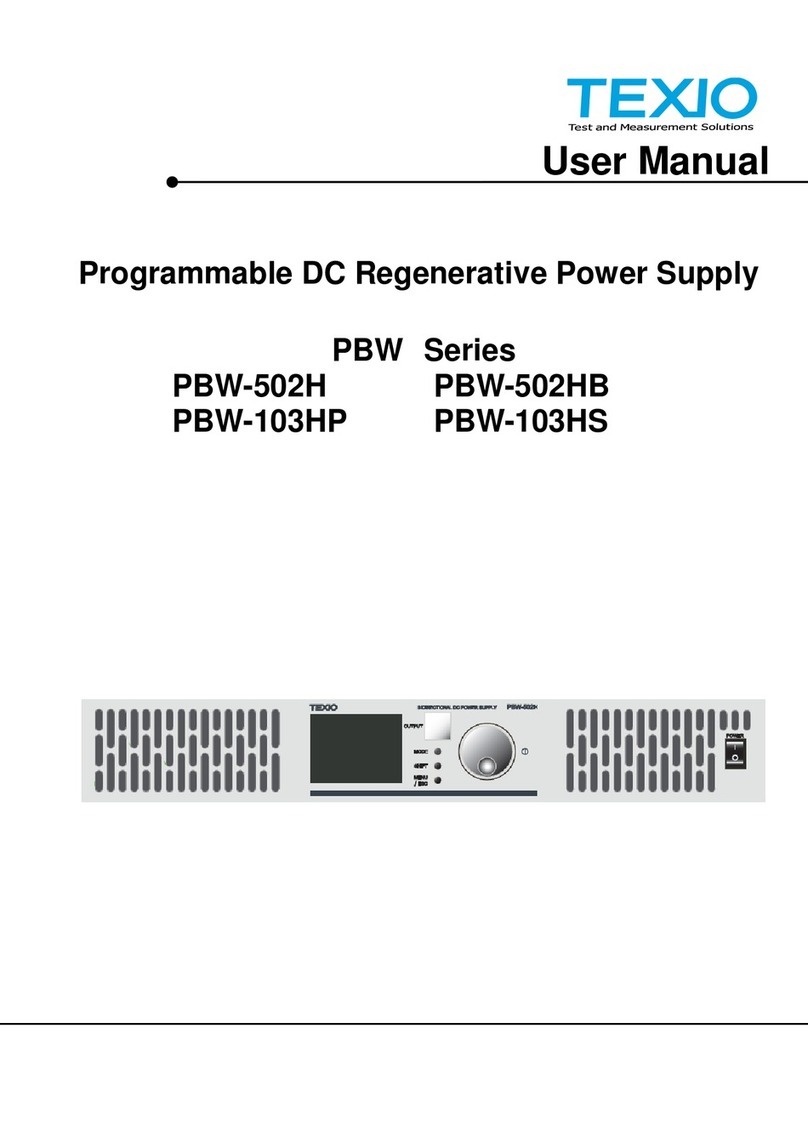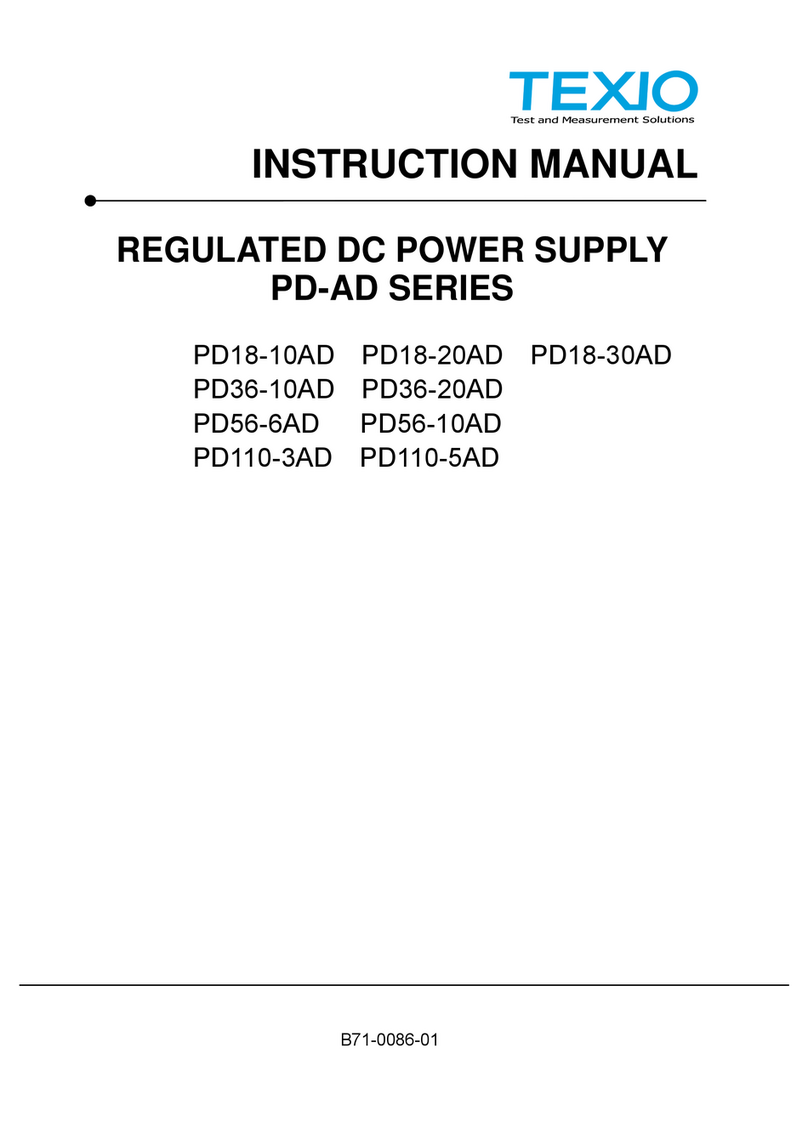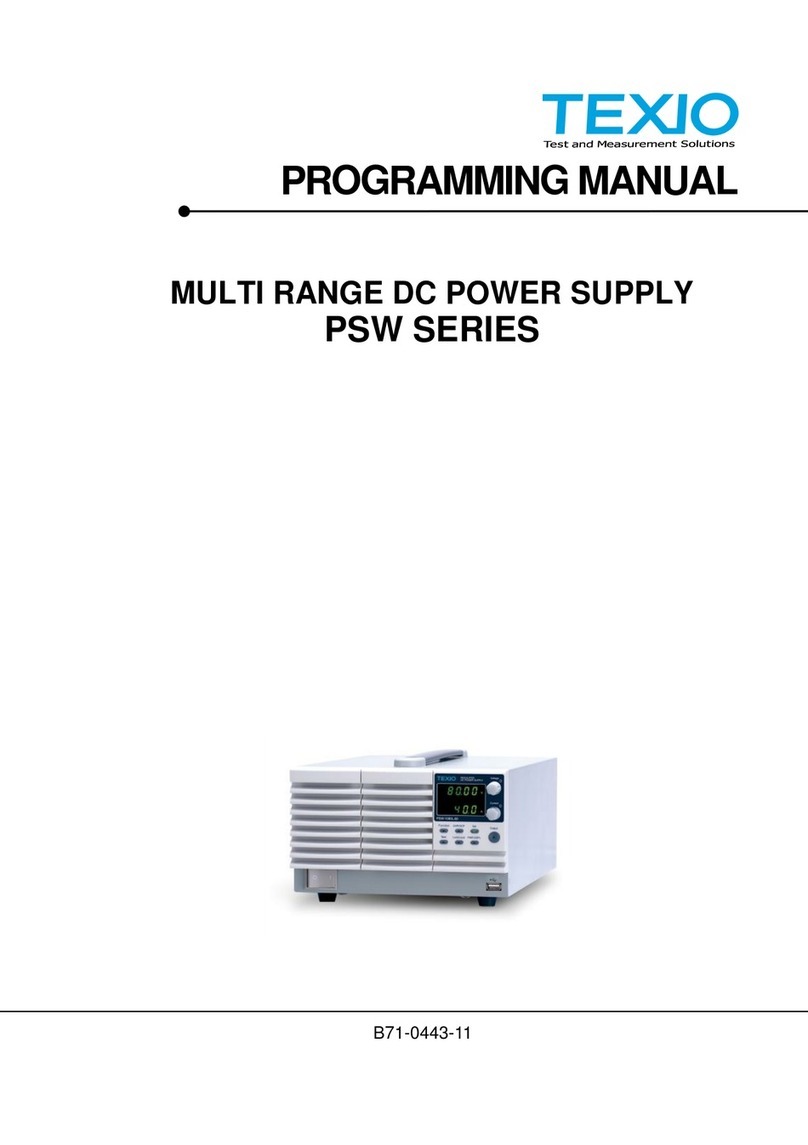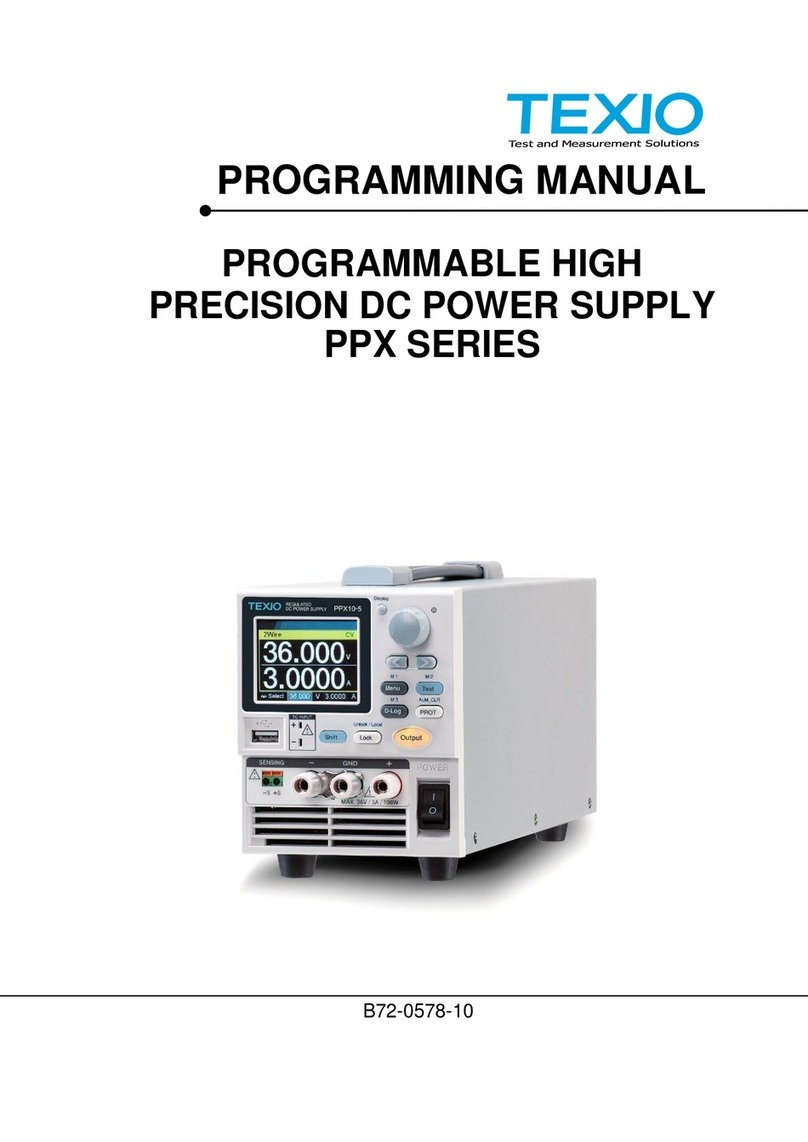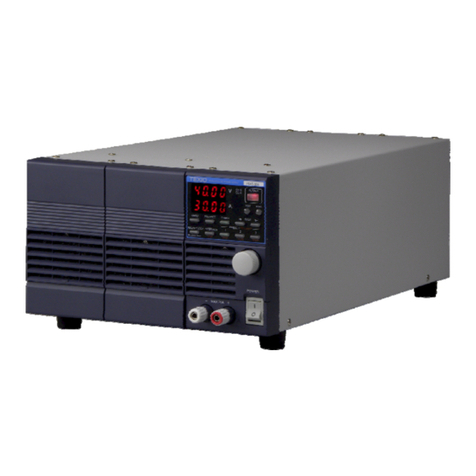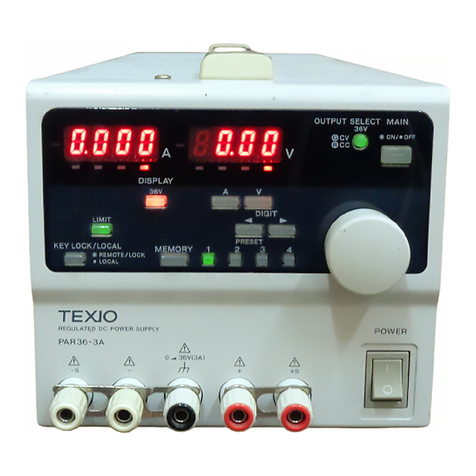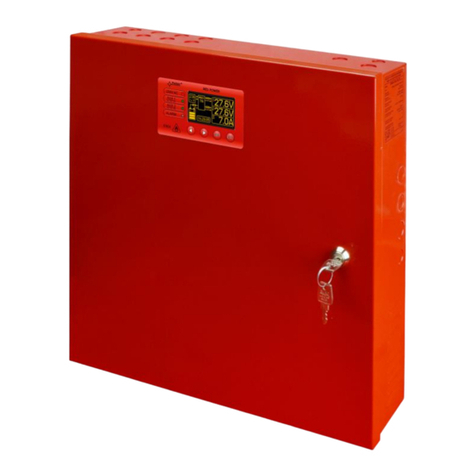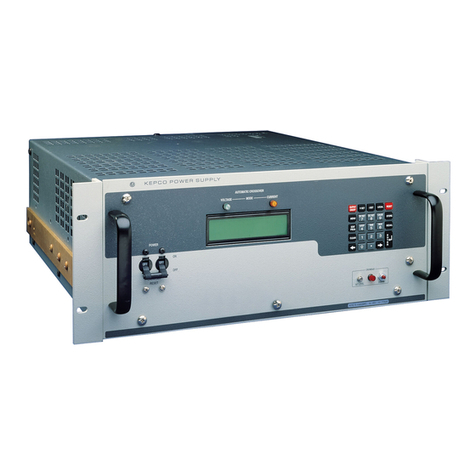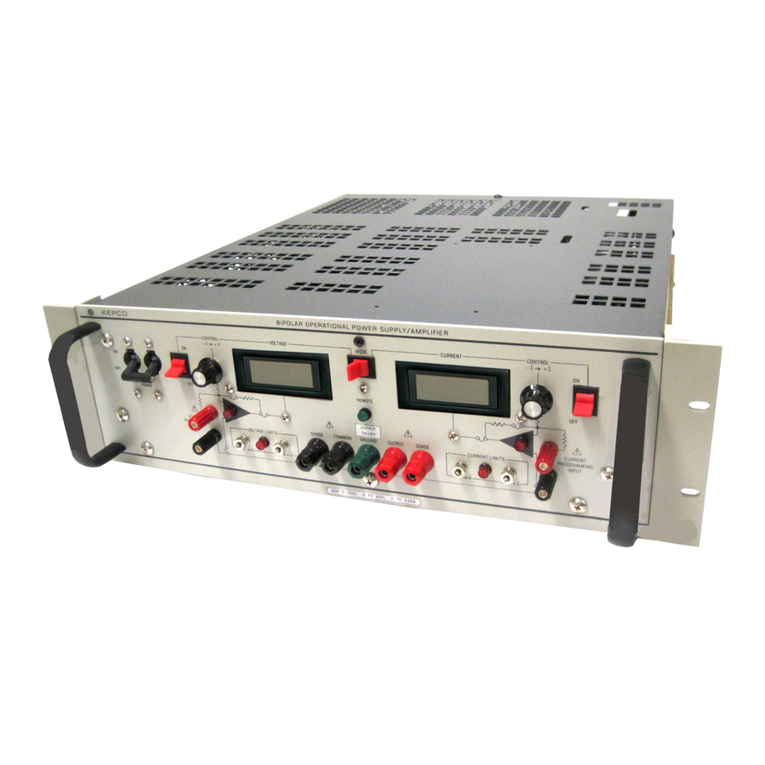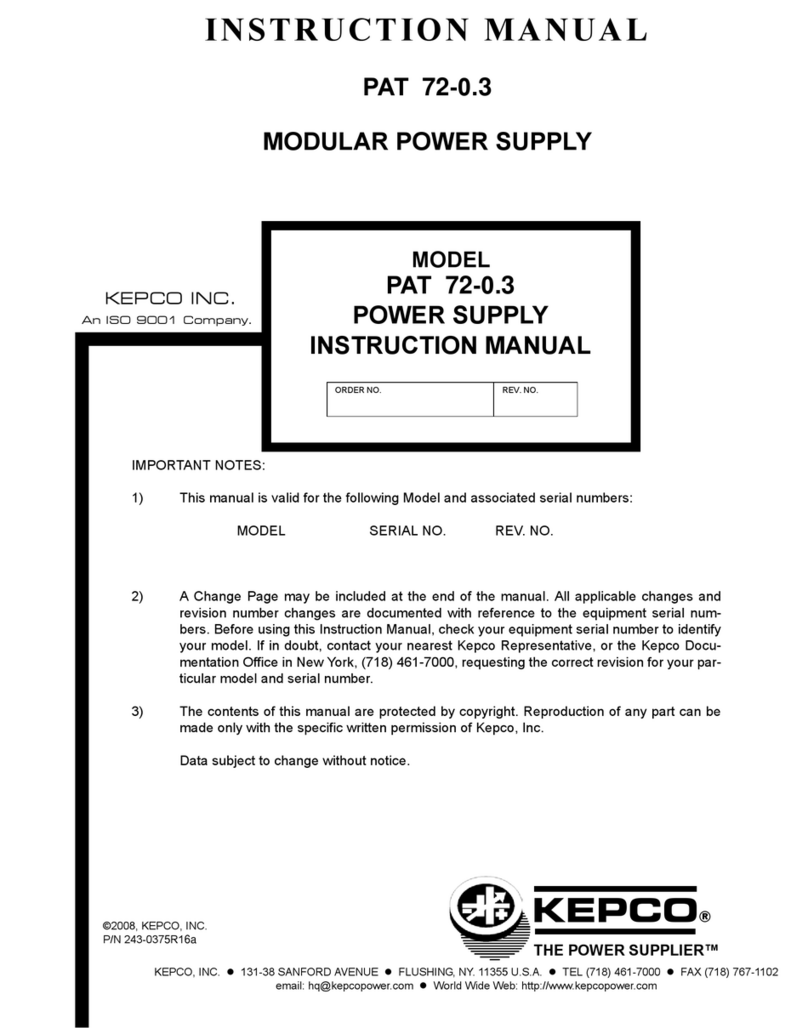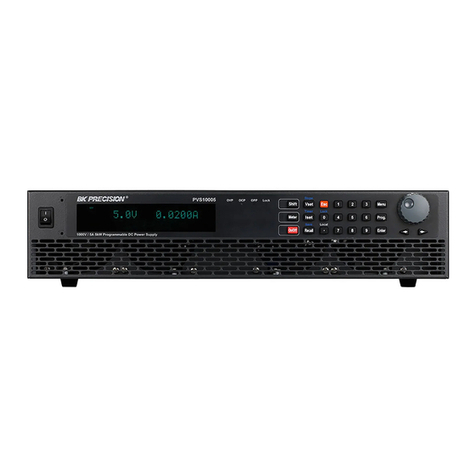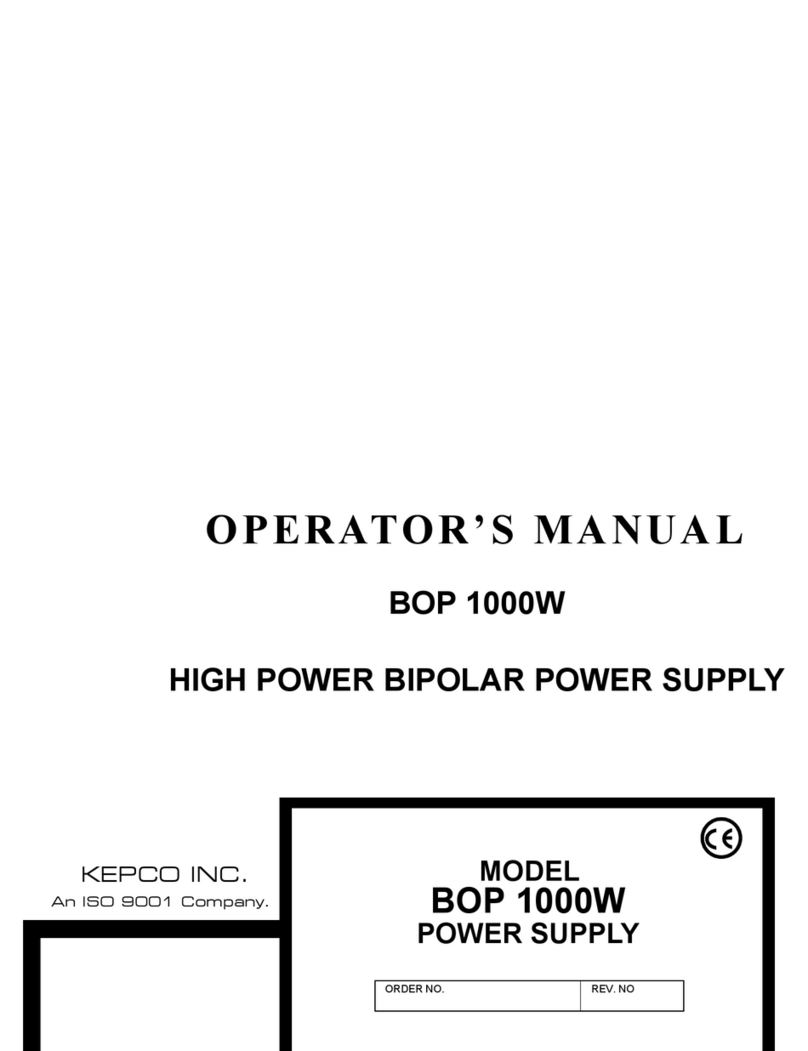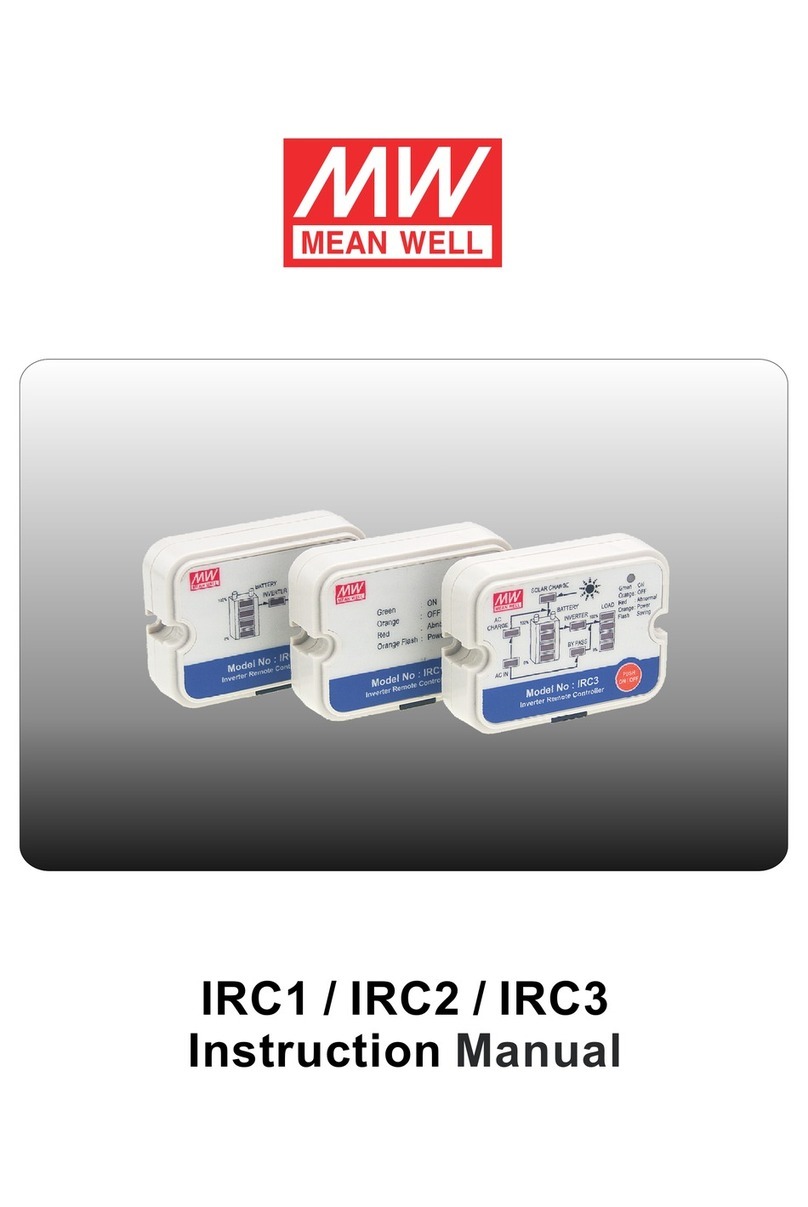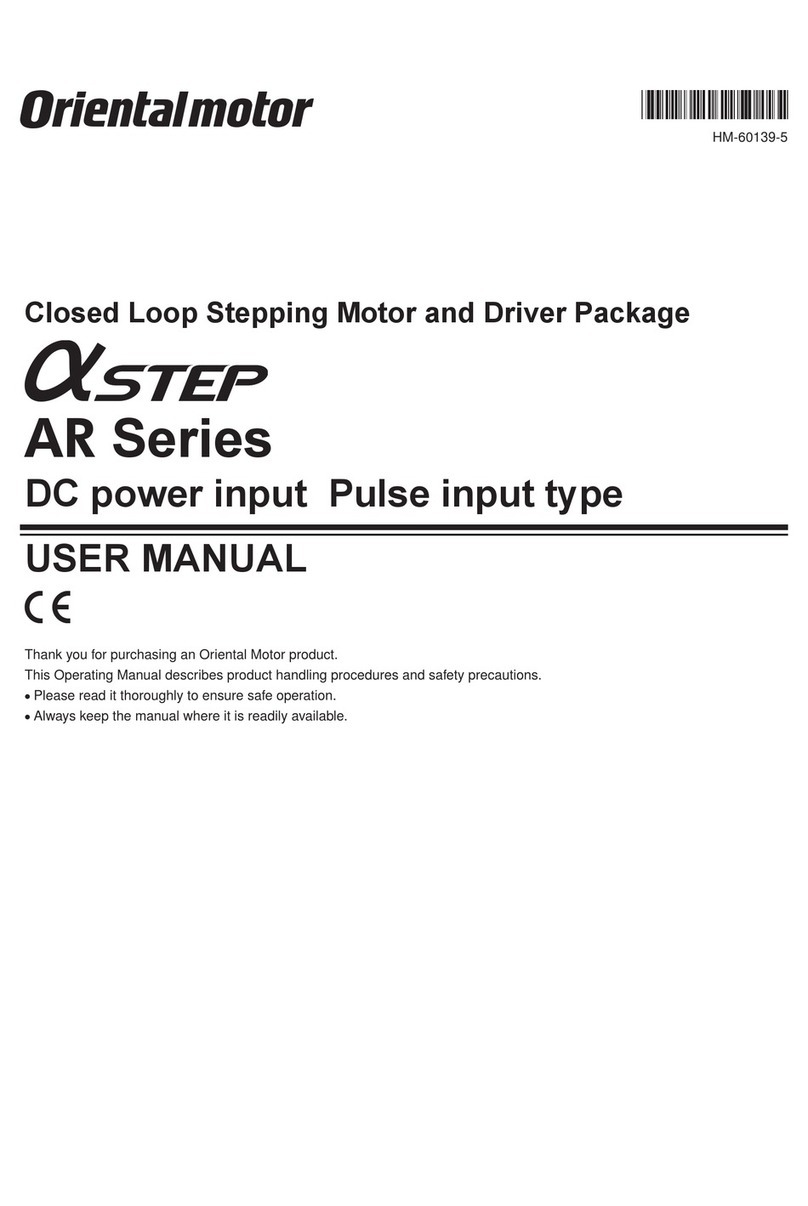TEXIO PU6-100 User manual

750W SERIES DC POWER SUPPLY
PU SERIES
PU6-100 6V/100A PU8-90 8V/90A
PU12.5-60 12.5V/60A PU20-38 20V/38A
PU30-25 3V/25A PU40-19 40V/19A
PU60-12.5 60V/12.5A PU80-9.5 80V/9.5A
PU100-7.5 100V/7.5A PU150-5 150V/5A
PU300-2.5 300V/2.5A PU600-1.3 600V/1.3A
INSTRUCTION MANUAL
© PRINTED IN JAPAN B65-0166-00


CONTENTS
WARRANTY.................................................................................................................................................................................................Ⅰ
SAFETY INSTRUCTIONS......................................................................................................................................................................Ⅱ
1. GENERAL INFORMATION........................................................................................................................................................ 1
1.1. USER MANUAL CONTENT...........................................................................................................1
1.2. INTRODUCTION ..........................................................................................................................1
1.2.1 General description .....................................................................................................................1
1.2.2 Models covered by this manual ....................................................................................................1
1.2.3 Features and options...................................................................................................................2
1.2.4 Multiple output power system ......................................................................................................2
1.2.5 Control via the serial communication port.....................................................................................2
1.2.6 Analog voltage programming and monitoring..................................................................................2
1.2.7 Parallel operation ........................................................................................................................3
1.2.8 Output connections.....................................................................................................................3
1.2.9 Cooling and mechanical construction............................................................................................3
1.3. ACCESSORIES............................................................................................................................3
1.3.1 General.......................................................................................................................................3
1.3.2 Serial link cable...........................................................................................................................3
1.3.3 Misc. hardware ............................................................................................................................3
1.3.4 AC cables ...................................................................................................................................3
1.3.5 Serial Port Cables .......................................................................................................................3
2. SPECIFICATIONS ....................................................................................................................................................................... 4
2.1. OUTPUT RATING ........................................................................................................................4
2.2. INPUT CHARACTERISTICS .........................................................................................................4
2.3. CONSTANT VOLTAGE MODE......................................................................................................4
2.4. CONSTANT CURRENT MODE......................................................................................................4
2.5. ANALOG PROGRAMMING AND MONITORING..............................................................................4
2.6. PROGRAMMING AND READBACK (RS232/485, Optional IEEE Interface) (At the time of 23℃±5℃) ..........5
2.7. PROTECTIVE FUNCTIONS ..........................................................................................................5
2.8. FRONT PANEL ............................................................................................................................5
2.9. ENVIRONMENTAL CONDITIONS..................................................................................................5
2.10. MECHANICAL..............................................................................................................................6
2.11. SAFETY/EMC..............................................................................................................................6
2.12. SUPPLEMENTAL CHARACTERISTICS .........................................................................................6
3. INSTALLATION............................................................................................................................................................................ 8
3.1. GENERAL....................................................................................................................................8
3.2. PREPARATION FOR USE ............................................................................................................8
3.3. INITIAL INSPECTION ...................................................................................................................8
3.4. RACK MOUNTING .......................................................................................................................8
3.5. LOCATION, MOUNTING AND COOLING.......................................................................................8
3.6. AC SOURCE REQUIREMENTS .....................................................................................................9
3.7. AC INPUT POWER CONNECTION ................................................................................................9
3.7.1 AC Input Connector ....................................................................................................................9
3.7.2 AC Input Cord.............................................................................................................................9

3.7.3 Time to Heat Beforehand.............................................................................................................9
3.8. TURN-ON CHECKOUT PROCEDURE .........................................................................................10
3.8.1 General.....................................................................................................................................10
3.8.2 Prior to Operation .....................................................................................................................10
3.8.3 Constant Voltage Check............................................................................................................10
3.8.4 Constant Current Check............................................................................................................10
3.8.5 OVP Check...............................................................................................................................11
3.8.6 UVL Check ...............................................................................................................................11
3.8.7 Foldback Check.........................................................................................................................11
3.8.8 Address Setting ........................................................................................................................12
3.8.9 Baud Rate Setting.....................................................................................................................12
3.9. CONNECTING THE LOAD..........................................................................................................13
3.9.1 Load Wiring ...............................................................................................................................13
3.9.2 Current Carrying Capacity .........................................................................................................13
3.9.3 Wire termination........................................................................................................................14
3.9.4 Noise and Impedance Effects.....................................................................................................14
3.9.5 Inductive loads..........................................................................................................................15
3.9.6 Making the load connections......................................................................................................15
3.9.7 Connecting single loads, local sensing (default). ..........................................................................18
3.9.8 Connecting single loads, remote sensing.....................................................................................18
3.9.9 Connecting multiple loads, radial distribution method...................................................................19
3.9.10 Multiple load connection with distribution terminals...................................................................19
3.9.11 Grounding outputs ...................................................................................................................19
3.10. LOCAL AND REMOTE SENSING ................................................................................................20
3.10.1 Sense wiring............................................................................................................................20
3.10.2 Local sensing ..........................................................................................................................20
3.10.3 Remote sensing.......................................................................................................................21
3.10.4 J2 sense connector technical information.................................................................................21
4. FRONT AND REAR PANEL CONTROLS AND CONNECTORS............................................................................... 22
4.1. INTRODUCTION ........................................................................................................................22
4.2. FRONT PANEL CONTROLS AND INDICATORS..........................................................................22
4.3. REAR PANEL ............................................................................................................................24
4.4. REAR PANEL SW1 SETUP SWITCH ...........................................................................................25
4.4.1 SW1 position functions ..............................................................................................................26
4.4.2 Resetting the SW1 switch..........................................................................................................26
4.5. REAR PANEL J1 PROGRAMMING AND MONITORING CONNECTOR ..........................................27
4.5.1 Making J1 connections ..............................................................................................................27
5. LOCAL OPERATION................................................................................................................................................................ 29
5.1. INTRODUCTION ........................................................................................................................29
5.2. STANDARD OPERATION...........................................................................................................29
5.2.1 Constant Voltage Mode .............................................................................................................29
5.2.2 Constant Current Operation ......................................................................................................30
5.2.3 Automatic Crossover.................................................................................................................30
5.3. OVER VOLTAGE PROTECTION (OVP).......................................................................................30
5.3.1 Setting the OVP level................................................................................................................31
5.3.2 Activated OVP protection indications.........................................................................................31

5.3.3 Resetting the OVP circuit..........................................................................................................31
5.4. UNDER VOLTAGE LIMIT (UVL)..................................................................................................31
5.4.1 Setting the UVL level ................................................................................................................31
5.5. FOLDBACK PROTECTION.........................................................................................................32
5.5.1 Setting the Foldback protection .................................................................................................32
5.5.2 Resetting activated Foldback protection.....................................................................................32
5.6. OUTPUT ON/OFF CONTROL ....................................................................................................32
5.7. OUTPUT SHUT-OFF (SO) CONTROL VIA REAR PANEL J1 CONNECTOR..................................32
5.8. ENABLE/DISABLE CONTROL VIA REAR PANEL J1 CONNECTOR.............................................33
5.9. CV/CC SIGNAL.........................................................................................................................34
5.10. PS_OK SIGNAL..........................................................................................................................34
5.11. SAFE START AND AUTO-RESTART MODES.............................................................................34
5.11.1 Automatic start mode ..............................................................................................................34
5.11.2 Safe start mode ......................................................................................................................34
5.12. OVER TEMPERATURE PROTECTION (OTP) ..............................................................................35
5.13. LAST SETTING MEMORY ..........................................................................................................35
5.14. SERIES OPERATION .................................................................................................................35
5.14.1 Series connection for increased output voltage.........................................................................36
5.14.2 Series connection for positive and negative output voltage .......................................................37
5.15. PARALLEL OPERATION ............................................................................................................38
5.16. DAISY-CHAIN CONNECTION.....................................................................................................39
5.17. FRONT PANEL LOCKING ..........................................................................................................40
5.17.1 Unlocked front panel................................................................................................................40
5.17.2 Locked front panel...................................................................................................................40
6. REMOTE ANALOG PROGRAMMING ................................................................................................................................. 41
6.1. INTRODUCTION ........................................................................................................................41
6.2. LOCAL /REMOTE ANALOG CONTROL......................................................................................41
6.3. LOCAL/REMOTE ANALOG INDICATION ....................................................................................41
6.4. REMOTE VOLTAGE PROGRAMMING OF OUTPUT VOLTAGE AND CURRENT LIMIT ..................42
6.5. RESISTIVE PROGRAMMING OF OUTPUT VOLTAGE AND CURRENT LIMIT ...............................43
6.6. REMOTE MONITORING OF OUTPUT VOLTAGE AND CURRENT ................................................44
7. RS232 & RS485 REMOTE CONTROL................................................................................................................................ 45
7.1. INTRODUCTION ........................................................................................................................45
7.2. CONFIGURATION......................................................................................................................45
7.2.1 Default setting ..........................................................................................................................45
7.2.2 Address setting.........................................................................................................................45
7.2.3 RS232 or RS485 selection .........................................................................................................45
7.2.4 Baud rate setting ......................................................................................................................45
7.2.5 Setting the unit into Remote or Local mode ...............................................................................46
7.2.6 RS232/485 port in Local mode ..................................................................................................46
7.2.7 Front panel in Remote mode......................................................................................................46
7.3. REAR PANEL RS232/485 CONNECTOR.....................................................................................47
7.4. CONNECTING POWER SUPPLIES TO RS232 OR RS485 BUS.....................................................47
7.4.1 Single power supply...................................................................................................................47
7.4.2 Multi power supply connection to RS232 or RS485 bus...............................................................48
7.4.3 Termination...............................................................................................................................49

7.5. COMMUNICATION INTERFACE PROTOCOL ..............................................................................49
7.5.1 Data format ..............................................................................................................................49
7.5.2 Addressing................................................................................................................................49
7.5.3 End of Message.........................................................................................................................49
7.5.4 Checksum.................................................................................................................................49
7.5.5 Acknowledge.............................................................................................................................49
7.5.6 Error message...........................................................................................................................49
7.5.7 Backspace ................................................................................................................................49
7.6. ERROR MESSAGES...................................................................................................................50
7.7. COMMAND SET DESCRIPTION .................................................................................................50
7.7.1 General guides ..........................................................................................................................50
7.7.2 Command set categories ...........................................................................................................50
7.7.3 Initialization control commands ..................................................................................................51
7.7.4 ID control commands.................................................................................................................51
7.7.5 Output control commands .........................................................................................................51
7.7.6 Status control commands ..........................................................................................................53
7.8. STATUS, ERROR AND SRQ REGISTERS....................................................................................54
7.8.1 General.....................................................................................................................................54
7.8.2 Conditional registers..................................................................................................................54
7.8.3 Service Request: Enable and Event Registers.............................................................................56
7.9. SERIAL COMMUNICATION TEST SET-UP......................................................................................58
8. ISOLATED ANALOG PROGRAMMING OPTION............................................................................................................ 59
8.1. INTRODUCTION ........................................................................................................................59
8.2. SPECIFICATIONS......................................................................................................................59
8.2.1 0-5V/0-10V option ...................................................................................................................59
8.2.2 4-20mA option..........................................................................................................................59
8.3. ISOLATED PROGRAMMING & MONITORING CONNECTOR ........................................................60
8.4. SETUP AND OPERATING INSTRUCTIONS.................................................................................61
8.4.1 Setting up the power supply for 0-5/0-10V Isolated Programming and Monitoring........................61
8.4.2 Setting up the power supply for 4-20mA Isolated Programming and Monitoring ............................61
9. MAINTENANCE .......................................................................................................................................................................... 62
9.1. INTRODUCTION ........................................................................................................................62
9.2. UNITS UNDER WARRANTY........................................................................................................62
9.3. PERIODIC MAINTENANCE .........................................................................................................62
9.4. FAN EXCHANGE........................................................................................................................62
9.5. PARTS REPLACEMENT AND REPAIRS......................................................................................62
9.6. TROUBLESHOOTING ................................................................................................................62
9.7. FUSE RATING ...........................................................................................................................63

I
LIMITATION OF WARRANTY
The warranty shall not apply to defects resulting from improper or inadequate usage or maintenance by
the buyer, buyer supplied products or interfacing. The warranty shall not apply to defects resulting from
unauthorized modifications or from operation exceeding the environmental specifications of the product or
if the QA seal has been removed or altered by anyone other than TEXIO authorized personnel. TEXIO does
not warrant the buyers circuitry or malfunctions of TEXIO products resulting from the buyer’s circuitry.
Furthermore, TEXIO does not warrant any damage occurring as a result of the buyer’s circuitry or the
buyer’s - supplied products.
No other warranty is expressed of implied.
WARRANTY SERVICE
This product must be returned to an authorized TEXIO service facility for repairs or other warranty
service. For products returned to TEXIO for warranty service, the buyer shall prepay shipping charges to
TEXIO and TEXIO shall pay the shipping charges to return the product to the buyer. Refer to section 3.11
for repackaging for shipment.
DISCLAIMER
The information contained in this document is subject to change without notice. TEXIO shall not be liable
for errors contained in this document or for incidental or consequential damages in connection with the
furnishing, performance or use of this material. No part of this document may be photocopied, reproduced
or translated into another language without the prior written consent of TEXIO.
TRADEMARK INFORMATION
Microsoft and Windows are trademarks of Microsoft Corporation.
THE FCC WANTS YOU TO KNOW
This equipment has been tested and found to comply with the limits for a Class A digital device, pursuant
to Part 15 of the FCC rules. These limits are designed to provide reasonable protection against harmful
interference when the equipment is operated in a commercial environment.
This equipment generates, uses and can radiate radio frequency energy and, if not installed and used in
accordance with the instructions, may cause harmful interference to radio communications.
Operation of this equipment in a residential area is likely to cause harmful interference, in which case the
user will be required to correct the interference at his own expense.
FCC WARNING
Modifications not expressly approved by manufacturer could void the user authority to operate the
equipment under FCC Rules.

II
SAFETY INSTRUCTIONS
CAUTION
The following safety precaution must be observed during all phases of operation, service and repair of this
equipment. Failure to comply with the safety precautions or warnings in this document violates safety
standards of design, manufacture and intended use of this equipment and may impair the built-in protections
within.
TEXIO shall not be liable for user’s failure to comply with these requirements.
INSTALLATION CATEGORY
The PU power supply series has been evaluated to INSTALLATION CATEGORY II.
Installation category (over voltage category) II: local level, appliances, portable equipment etc. With smaller
transient over voltage than Installation Category (over voltage category) III.
GROUNDING
This product is a Safety Class 1 instrument. To minimize shock hazard, the instrument chassis must be
connected to an electrical ground. The instrument must be connected to the AC power supply mains
through a three conductor power cable, with the ground wire firmly connected to an electrical ground
(safety ground) at the power outlet.
For instruments designed to be hard-wired to the supply mains, the protective earth terminal must be
connected to the safety electrical ground before another connection is made. Any interruption of the
protective ground conductor, or disconnection of the protective earth terminal will cause a potential shock
hazard that might cause personal injury.
FUSES
Fuses must be changed by authorized TEXIO service personnel only. For continued protection against risk
of fire, replace only with the same type and rating of fuse. Refer to maintenance instructions in chapter 9
for fuses rating.
INPUT RATINGS
Do not use AC supply, which exceeds the input voltage and frequency rating of this instrument. The input
voltage and frequency rating of the PU power supply series is: 100-240V, 50/60Hz.
For safety reasons, the mains supply voltage fluctuations should not exceed +/-10% of nominal voltage.
LIVE CIRCUITS
Operating personnel must not remove the instrument cover. No internal adjustment or component
replacement is allowed by non-TEXIO qualified personnel. Never replace components with power cable
connected. To avoid injuries, always disconnect power, discharge circuits and remove external voltage
source before touching components.
WARNING
OUTPUT TERMINAL GROUNDING
There is a potential shock hazard at the RS232/485 and the IEEE ports when using power supplies
with rated or combined voltage greater than 400V and the Positive Output of the Power Supply is
grounded. Do Not connect the Positive Output to ground when using the RS232/485 or IEEE.

III
PARTS SUBSTITUTIONS & MODIFICATIONS
Parts substitutions and modifications are allowed by authorized TEXIO service personnel only. For repairs
or modifications, the instrument must be returned to TEXIO service facility.
ENVIRONMENTAL CONDITIONS
The PU power supply series safety approval applies to the following operating conditions:
*Indoor use
*Ambient temperature: 0℃ to 50℃
*Maximum relative humidity: 90% (no condensation)
*Altitude: up to 3000m
*Pollution degree 2
CAUTION Risk of Electrical Shock.
Instruction manual symbol. The instrument will be marked with this symbol when it is
necessary for the user to refer to the instruction manual.
Indicates hazardous voltage.
Indicates ground terminal.
Protective Ground Conductor Terminal
Off (Supply)
On (Supply)
WARNING The WARNING sign denotes a hazard. An attention to a procedure is called.
Not following procedure correctly could result in personal injury.
AWARNING sign should not be skipped and all indicated conditions must be fully understood
and met.
CAUTION The CAUTION sign denotes a hazard. An attention to a procedure is called. Not following
procedure correctly could result in damage to the equipment. Do not proceed beyond a
CAUTION sign until all indicated conditions are fully understood and met.
FCC COMPLIANCE NOTICE:
Note: This equipment has been tested and found to comply with the limits for a ClassA digital device,
pursuant to part 15 of the FCC Rules. These limits are designed to provide reasonable protection against
harmful interference when the equipment is operated in a commercial environment. This equipment
generates uses, and can radiate radio frequency energy and, if not installed and used in accordance with
the instruction manual, may cause harmful interference to radio communications. Operation of this
equipment in a residential area is likely to cause harmful interference in which case the user will be
required to correct the interference at his own expense.


1
1. GENERAL INFORMATION
1.1. USER MANUAL CONTENT
This user’s manual contains the operating instructions, installation instructions and specifications of
the PU 750W power supply series. The instructions refer to the standard power supplies, including the
built-in RS232/485 serial communication. For information related to operation with the optional IEEE
programming, refer to User Manual for Power Supply IEEE programming Interface.
1.2. INTRODUCTION
1.2.1 General description
PU power supplies are wide output range, high performance switching power supplies. The PU series
is power factor corrected and operates from worldwide AC voltage range continuously. Output
voltage and current are continuously displayed and LED indicators show the complete operating
status of the power supply. The Front panel controls allow the user to set the output parameters, the
protection levels (Over-Voltage protection, Under-Voltage limit and Foldback) and preview the
settings. The rear panel includes the necessary connectors to control and monitor the power supply
operation by remote analog signals or by the built-in serial communication (RS232/485). GPIB
programming and Isolated-Analog programming/monitoring are optional.
1.2.2 Models covered by this manual
Table1-1: Models covered by the manual
Model Voltage Current
range(V) range(A)
PU6-100 0-6 0-100
PU8-90 0-8 0-90
PU12.5-60 0-12.5 0-60
PU20-38 0-20 0-38
PU30-25 0-30 0-25
PU40-19 0-40 0-19
PU60-12.5 0-60 0-12.5
PU80-9.5 0-80 0-9.5
PU100-7.5 0-100 0-7.5
PU150-5 0-150 0-5
PU300-2.5 0-300 0-2.5
PU600-1.3 0-600 0-1.3

2
1.2.3 Features and options
* Constant Voltage / Constant Current with automatic crossover.
* Harmonics current control circuit built-in and EN61000-3-2 class A conformity (Power factor
0.99 [with a built-in active filter]).
* Universal Input Voltage 85-265V AC, continuous operation.
* Embedded Microprocessor Controller.
* Built in RS232/485 Interface.
* Voltage & Current high resolution adjustment by digital encoders.
* High accuracy programming/readback-16 bit.
* Software Calibration (no internal trimmers / potentiometers).
* Last Setting Memory.
* Independent Remote ON/OFF (opt-isolated) and Remote Enable/Disable.
* Parallel operation (Master/Slave) with Active current sharing.
* Remote sensing to compensate for voltage drop of power leads.
* Cooling fan speed control for low noise and extended fan life.
* Zero stacking- no ventilation holes at the top and bottom surface of the power supply.
* Optional GPIB interface (SCPI compatible).
* Optional Isolated Analog programming/monitoring (0-5V or 0-10V, user selectable and
4-20mA).
1.2.4 Multiple output power system
The PU power supplies series can be configured into a programmable power system of up to 31
units using the built-in RS232/RS485 communication port in the power supply and the RS485
linking cable provided with each power supply.
In a GPIB system, each power supply can be controlled using the optional GPIB controller (factory
installed).
1.2.5 Control via the serial communication port
The following parameters can be programmed via the serial communication port:
1. Output voltage setting.
2. Output current setting.
3. Output voltage measurement.
4. Output current measurement.
5. Output on/off control.
6. Foldback protection setting.
7. Over-voltage protection setting and readback.
8. Under-Voltage limit setting and readback.
9. Power-supply start up mode (last setting or safe mode).
1.2.6 Analog voltage programming and monitoring
Analog inputs and outputs are provided at the rear panel for analog control of the power supply. The
output voltage and the current limit can be programmed by analog voltage or by resistor, and can be
monitored by analog voltage. The power supply output can be remotely set to On or Off and analog
signals monitor the proper operation of the power supply and the mode of operation (CV/CC).

3
1.2.7 Parallel operation
PU power supplies of the same output voltage and current rating can be paralleled in master-slave
configuration with automatic current sharing to increase power available.
1.2.8 Output connections
Output connections are made to rear panel bus-bars for models up to 60V and to a 4-terminal wire
clamp connector for models above 60V rated output voltage. Either the positive or negative
terminal may be grounded or the output may be floated. Models up to 60VDC Rated Output shall
not float outputs more than +/- 60VDC above/below chassis ground. Models >60VDC Rated
Output shall not float outputs more than +/-600VDC above/below chassis ground. Contact factory
for assistance with higher float voltage applications.
Local or remote sense may be used. In remote sense, the voltage drop on the load wires should be
minimized. Refer to the specifications for the maximum voltage drop value.
1.2.9 Cooling and mechanical construction
The PU series is cooled by internal fans. At the installation, care must be taken to allow free airflow
into the power supply via the front panel and out of the power supply via the rear panel. The PU
power supplies have a compact and lightweight package, which allows easy installation and space
saving in the application equipment.
CAUTION
1.3. ACCESSORIES
1.3.1 General
Accessories are delivered with the power supply or separately upon ordering. The list below shows
the possible accessories and ordering numbers.
1.3.2 Serial link cable
Serial link cable, for linking power supplies by RS485 communication is provided with the power
Supply.
Cable description 0.5m length, shielded, RJ-45 type plugs, and 8 contacts.
1.3.3 Misc. hardware
* DB25 plug (AMP, 745211-2)
* Output terminal shield
1.3.4 AC cables
Ac cables are provided with the power supply.
10A250V, unshielded, 2m typical length, with IEC320 connector on one end and INT’L7 standard Vll,
dual earthing.
1.3.5 Serial Port Cables
Refer to section 7.4.
Observe all torque guidelines within this manual. Over torqueing may damage.
Unit or accessories. Such damage is not covered under manufacturers warranty.

4
2. SPECIFICATIONS
2.1. OUTPUT RATING
MODEL 6-100 8-90 12.5-60 20-38 30-25 40-19 60-12.5 80-9.5 100-7.
5 150-5 300-2.5 600-1.3
1.Rated output voltage (*1) V 6 8 12.5 20 30 40 60 80 100 150 300 600
2.Rated output current (*2) A 100 90 60 38 25 19 12.5 9.5 7.5 5 2.5 1.3
3.Rated output power W 600 720 750 760 750 760 750 760 750 750 750 780
2.2. INPUT CHARACTERISTICS
V 6 8 12.5 20 30 40 60 80 100 150 300 600
1.Input voltage/freq. (*3) - 85~265V AC continuous, 47~63Hz, single phase.
2.Input current
(at 100/200V AC) A 10.5/5
3.Power Factor - 0.99@100/200V AC、rated output power.
4.Efficiency (*4) % 76/78 77/80 81/84 82/85 82/85 83/87 83/87 83/87 83/87 83/87 83/87 83/87
5.Inrush current at 100/200V A Less than 25A.
2.3. CONSTANT VOLTAGE MODE
V 6 8 12.5 20 30 40 60 80 100 150 300 600
1.Max. Line regulation (*5) - 0.01% of rated output voltage +2mV
2.Max Load regulation (*6) - 0.01% of rated output voltage +2mV
3.Ripple and noise(p-p,20MHz)
(Following 30 minutes
warm-up).
mV 60 60 60 60 60 60 60 80 80 100 150 300
4.Ripple r.m.s., 5Hz~1MHz
(Following 30 minutes
warm-up.)
mV 8 8 8 8 8 8 8 8 8 10 25 60
5.Temperature coefficient ppm/℃ 100ppm/℃ from rated output voltage, following 30 minutes warm-up.
6.Temperature drift - 0.05% of rated Vout over 8hours interval following 30 minutes warm-up. Constant line, load & temp.
7.Rem.sense compensation/wire V 1 1 1 1 1.5 2 3 4 5 5 5 5
8.Up-prog. response time,
0~Vomax (*9) mS 90 120 150 250
9.Down-prog .response time:
Full load (*10) mS 10 50 80 150 250
No load (*11) mS 500 600 700 900 1000 1100 1200 1400 1700 2400 3000 4800
10.Transient response time
mS
Time for the output voltage to recover within 0.5% of its rated output for a load change 10~90% of rated
output current.
Output set-point: 10~100%.
Less than 1mS, for models up to and including 100V. 2mS, for models above 100V.
11.Hold-up time mS More than 20mS, 100V AC, rated output power.
2.4. CONSTANT CURRENT MODE
V 6 8 12.5 20 30 40 60 80 100 150 300 600
1.Max. Line regulation (*5) - 0.01% of rated output current +2mA
2.Max. Load regulation (*7) - 0.02% of rated output current +5mA
3.Ripple r.m.s. 5Hz~1MHz(*8) mA 200 180 120 76 63 48 38 29 23 18 13 8
4.Temperature coefficient ppm/℃ 100ppm/℃ from rated output current, following 30 minutes warm-up.
5.Temperature drift - 0.05% of rated Iout over 8hours interval following 30 minutes warm-up. Constant line, load & temp.
2.5. ANALOG PROGRAMMING AND MONITORING
1. Vout voltage programming --- 0~100%, 0~5V/0~10V, user select. Accuracy and linearity: +/-0.5% of rated Vout.
2. Iout voltage programming --- 0~100%, 0~5V/0~10V, user select. Accuracy and linearity: +/-1% of rated Iout.

5
3. Vout resistor programming --- 0~100%, 0~5/0~10kΩ full scale, user select. Accuracy and linearity: +/-1% of rated Vout.
4. Iout resistor programming --- 0~100%, 0~5/0~10kΩfull scale, user select. Accuracy and linearity: +/-1.5% of rated Iout.
5. On/off control --- By electrical Voltage: 0~0.6V/2~15V or dry contact, user selectable logic.
6. Output current monitor --- 0~5V or 0~10V, user selectable. Accuracy: 1%.
7. Output voltage monitor --- 0~5V or 0~10V, user selectable. Accuracy: 1%.
8. Power supply OK signal --- 4~5V-OK, 0V-Fail. 500ohm series resistance.
9. Parallel operation --- Possible, up to 4 units in master/slave mode with single wire current balance connection.
10. Series operation --- Possible (with external diodes), up to 2 units.
11. CV/CC indicator --- CV: TTL high (4~5V), source current: 10mA, CC: TTL low (0~0.6V), sink current: 10mA.
12. Enable/Disable --- Dry contact. Open: off, Short: on. Max. voltage at Enable/Disable in: 6V.
13. Local/Remote
analog control --- By electrical signal or Open/Short: 0~0.6V or short: Remote, 4~5V or open: Local.
14.Local/Remote
Analog status signal. --- Open collector. Local: Open, Remote: On, Maximum voltage: 30V, maximum sink current: 5mA.
2.6. PROGRAMMING AND READBACK (RS232/485, Optional IEEE Interface) (At the time of 23℃
±5℃)
1. Vout programming accuracy --- 0.1%+0.05% of rated output voltage
2. Iout programming accuracy --- 0.1%+0.15% of rated output current
3. Vout programming resolution --- 0.012% of full scale
4. Iout programming resolution --- 0.012% of full scale
5. Vout readback accuracy --- 0.1%+0.15% of rated output voltage
6. Iout readback accuracy --- 0.1%+0.35% of rated output current
7. Vout readback resolution --- 0.012% of full scale
8. Iout readback resolution --- 0.012% of full scale
2.7. PROTECTIVE FUNCTIONS
V 6 8 12.5 20 30 40 60 80 100 150 300 600
1.Foldback protection -- Output shut-down when power supply change from CV to CC User presetable.
2.Over-voltage protection -- Inverter shut-down, manual reset by AC input recycle or by OUT button.
3.Over-voltage trip point V 0.5~7.5 0.5~10 1~15 1~24 2~36 2~44 5~66 5~88 5~110 5~165 5~330 5~660
4.Output under voltage limit -- Preset by front panel or communication port. Prevents from adjusting Vout bellow limit.
Raises the PS_OK signal in case of output voltage is bellow limit.
5.Over temperature protection -- User selectable, latched or non latched
2.8. FRONT PANEL
-- Vout/Iout manual adjust by separate encoders (coarse and fine adjustment).
-- OVP/UVL manual adjust by Vout. Adjust encoder.
-- Address selection by Voltage Adjust encoder. No of addresses: 31.
-- Go to local control.
-- Output on/off
-- AC on/off
-- Front panel Lock
-- Foldback control
-- Baud rate selection: 1200, 2400, 4800, 9600, and 19200.
1.Control functions
-- Re-start modes (automatic restart, safe mode).
-- Vout: 4 digits, accuracy: 0.5% of rated output voltage +/-1count. 2.Display
-- Iout: 4 digits, accuracy: 0.5% of rated output current +/-1count.
3.Indications -- VOLTAGE, CURRENT, ALARM, FINE, PREVIEW, FOLDBACK, LOCAL, OUTPUT ON.
2.9. ENVIRONMENTAL CONDITIONS
1. Operating temperature -- 0~50℃, 100% load.
2. Storage temperature -- -20~70℃
3. Operating humidity % 30~90% RH (no condensation).
4. Storage humidity % 10~95% RH (no condensation).
5. Altitude -- Maximum 3000m. Derate output current by 2%/100m above 2000m. Alternatively, derate maximum ambient
temperature by 1℃/100m above 2000m.

6
2.10. MECHANICAL
1.Cooling -- Forced air cooling by internal fans.
2.Weight kg Less than 4.5kg.
3. Dimensions(WxHxD) mm W: 214.0, H: 43.6(57.0 Benchtop Version), D: 437.5(Refer to Outline drawing).
4.Vibration -- MIL-810E, method 514.4, test condition 1-3.3.1
5.Shock -- Less than 20G, half sine, 11mS. Unit is unpacked.
2.11. SAFETY/EMC
EN60950.
Vout=60V: Output is SELV, IEEE/Isolated analog are SELV.
60<Vout=400V: Output is hazardous, IEEE/Isolated analog are SELV.
400<Vout=600V: Output is hazardous, IEEE/Isolated analog are not SELV.
1.Applicable standards: Safety
EMC
--
EN55024
2.Withstand voltage
--
Vout=60V models: Input-Outputs(SELV): 3.0KVrms 1min, Input-Ground: 2.0KVrms 1min,
60<Vout=600V models: Input-Haz. Output: 2.5KVrms 1min, Input-SELV: 3KVrms 1min,
Hazardous Output-SELV: 1.9KVrms 1min, Hazardous Output-Ground: 1.9KVrms 1min,
Input-Ground: 2.0KVrms 1min.
3.Insulation resistance -- More than 100Mohm at 25℃, 70%RH.
4.Conducted emission -- Conforms to EN55022B, FCC part 15-B, VCCI-B
5.Radiated emission -- Conforms to EN55022B, FCC part 15-A, VCCI-A
NOTES:
*1: Minimum voltage is guaranteed to maximum 0.2% of the rated output voltage.
*2: Minimum current is guaranteed to maximum 0.4% of the rated output current.
*3: For cases where conformance to various safety standards (UL, IEC etc.) is required, to be
described as 100-240V AC (50/60Hz).
*4: At 100/200V AC input voltage and maximum output power.
*5: From 85-132V AC or 170-265V AC, constant load.
*6: From No-load to Full-load, constant input voltage. Measured at the sensing point in Remote
Sense.
*7: For load voltage change, equal to the unit voltage rating, constant input voltage.
*8: For 6V models the ripple is measured at 2-6V output voltage and full output current. For other
models, the ripple is measured at 10-100% output voltage and full output current.
*9: From 10% to 90% of rated output voltage, With rated resistive load.
*10: From 90% to 10% of rated output voltage, with rated resistive load.
*11: From 90% to 10% of rated output voltage.
2.12. SUPPLEMENTAL CHARACTERISTICS
The supplemental characteristics data is held in each TEXIO sales and service facility. For further
details please contact the TEXIO agent nearest you.

7

8
3. INSTALLATION
3.1. GENERAL
This chapter contains instructions for initial inspection, preparation for use and repackaging for
shipment. Connection to PC, setting the communication port and linking PU power supplies are
described in Chapter 7.
NOTE
PU power supplies generate magnetic fields, which might affect the
operation of other instruments. If your equipment is susceptible to
magnetic fields, do not position it adjacent to the power supply.
3.2. PREPARATION FOR USE
In order to be operational the power supply must be connected to an appropriate AC source. The AC
source voltage should be within the power supply specification. Do not apply power before reading,
Section 3.6 and 3.7.
Table 3-1 below, describes the basic setup procedure. Follow the instructions in Table 3-1 in the
sequence given to prepare the power supply for use.
Table 3-1: Basic setup procedure
Step no. Item Description Reference
1 Inspection Initial physical inspection of the power supply Section 3.3
2 Installation Installing the power supply,
Ensuring adequate ventilation.
Section 3.4
Section 3.5
3 AC source AC source requirements
Connecting the power supply to the AC source.
Section 3.6
Section 3.7
4 Test Turn-on checkout procedure. Section 3.8
5 Load connection Wire size selection. Local /Remote sensing.
Single or multiple loads. Section 3.9
6 Default setting The power supply setting at shipment. Section 7.2.1
3.3. INITIAL INSPECTION
Prior to shipment this power supply was inspected and found free of mechanical or electrical defects.
Upon unpacking of the power supply, inspect for any damage, which may have occured in transit.
The inspection should confirm that there is no exterior damage to the power supply such as broken
knobs or connectors and that the front panel and meters face are not scratched or cracked. Keep all
packing material until the inspection has been completed. If damage is detected, file a claim with
carrier immediately and notify the TEXIO agent nearest you.
3.4. RACK MOUNTING
Contact the TEXIO When Rack Mounting Kit is required.
3.5. LOCATION, MOUNTING AND COOLING
This power supply is fan cooled. The air intake is at the front panel and the exhaust is at the rear
panel. Upon installation allow cooling air to reach the front panel ventilation inlets. Allow minimum
15cm of unrestricted air space at the front and the rear of the unit.
The power supply should be used in an area that the ambient temperature does not exceed +50℃.

9
3.6. AC SOURCE REQUIREMENTS
The PU series can be operated from a nominal 100V to 240V, single phase, 47-63Hz. The input
voltage range and current required for each model is specified in Chapter 2. Ensure that under heavy
load, the AC voltage supplied to the power supply does not fall below the specifications described in
Chapter 2.
3.7. AC INPUT POWER CONNECTION
CAUTION
Connection of this power supply to an AC power source should be
made by an electrician or other qualified personnel.
WARNING
There is a potential shock hazard if the power supply chassis (with
cover in place) is not connected to an electrical safety ground via
the safety ground in the AC input connector.
WARNING
Some components inside the power supply are at AC voltage even
when the On/Off switch is in the “Off” position. To avoid electric
shock hazard, disconnect the line cord and load and wait two minutes
before removing cover.
3.7.1 AC Input Connector
An IEC connector is provided on the rear panel for connecting the unit to the AC power source with
an AC cord. The IEC connector also provides the safety ground connection while the AC cord is
plugged into an appropriate AC receptacle.
3.7.2 AC Input Cord
WARNING
The AC input cord is the disconnect device of the power supply. The
plug must be readily identifiable and accessible to the user. The AC
input cord must be no longer than 3m.
Refer to section1.3.4 for details of the AC input cords recommended for the PU 750Wmodels.
3.7.3 Time to Heat Beforehand
In order to obtain the performance of regulation of this machine, please carry out aging
30 minutes or more.

10
3.8. TURN-ON CHECKOUT PROCEDURE
3.8.1 General
The following procedure ensures that the power supply is operational and may be used as a basic
incoming inspection check. Refer to Fig.4-1 and Fig.4-2 for the location of the controls indicated in
the procedure.
3.8.2 Prior to Operation
1. Ensure that the power supply is configured to the default setting:
-AC On/Off switch at Off position.
-Dip switch : All positions at Down (”Off”) position.
-Sense connector : Configured to Local Sense as shown in Fig.3-4:
1 Remote (+) sense +S
2 Local (+) sense +LS
3 Not connected Plug P/N: MC 1.5/5-ST-3.81
4 Local (-) sense -LS (Phoenix)
5 Remote (-) sense -S
Fig.3-4: Sense connector default connection
-For units equipped with IEEE option, ensure that the IEEE_En switch is in Up (default) position
(Refer to Fig.4-2, item 8 for location), if checkout is to be done in IEEE mode.
2. Connect the unit to an AC source as described in section 3.7.
3. Connect a DVM with appropriate cables for the rated voltage to the output terminals.
4. Turn the front panel AC power switch to On.
3.8.3 Constant Voltage Check
1. Turn on the output by pressing OUTPUT pushbutton so the OUTPUT LED illuminates.
2. Observe the power supply VOLT display and rotate the Voltage encoder. Ensure that the output
voltage varies while the VOLT encoder is rotated. The minimum control range is from zero to the
maximum rated output for the power supply model.
Compare the DVM reading with the front panel VOLT display to verify the accuracy of the VOLT
display. Ensure that the front panel CV LED is on.
3. Turn off the front panel AC power switch.
3.8.4 Constant Current Check
1. Ensure that the front panel AC power switch is at Off position and the DVM connected to the
output terminals shows zero voltage.
2. Connect a DC shunt across the output terminals. Ensure that the shunt and the wires' current
ratings are higher than the power supply rating. Connect a DVM to the shunt.
3. Turn the front panel AC power switch to on position.
4. Turn on the output by pressing OUTPUT pushbutton so the OUTPUT LED illuminates.
5. Observe the power supply CURRENT display and rotate the CURRENT encoder. Ensure that the
output current varies while the CURRENT encoder is rotated. The minimum control range is from
zero to the maximum rated output for the power supply model.
6. Compare the DVM reading with the front panel CURRENT display to verify the accuracy of the
CURRENT display. Ensure that the front panel CC LED is on.
7. Turn off the front panel AC power switch.
8. Remove the shunt from the power supply output terminals.
This manual suits for next models
11
Table of contents
Other TEXIO Power Supply manuals
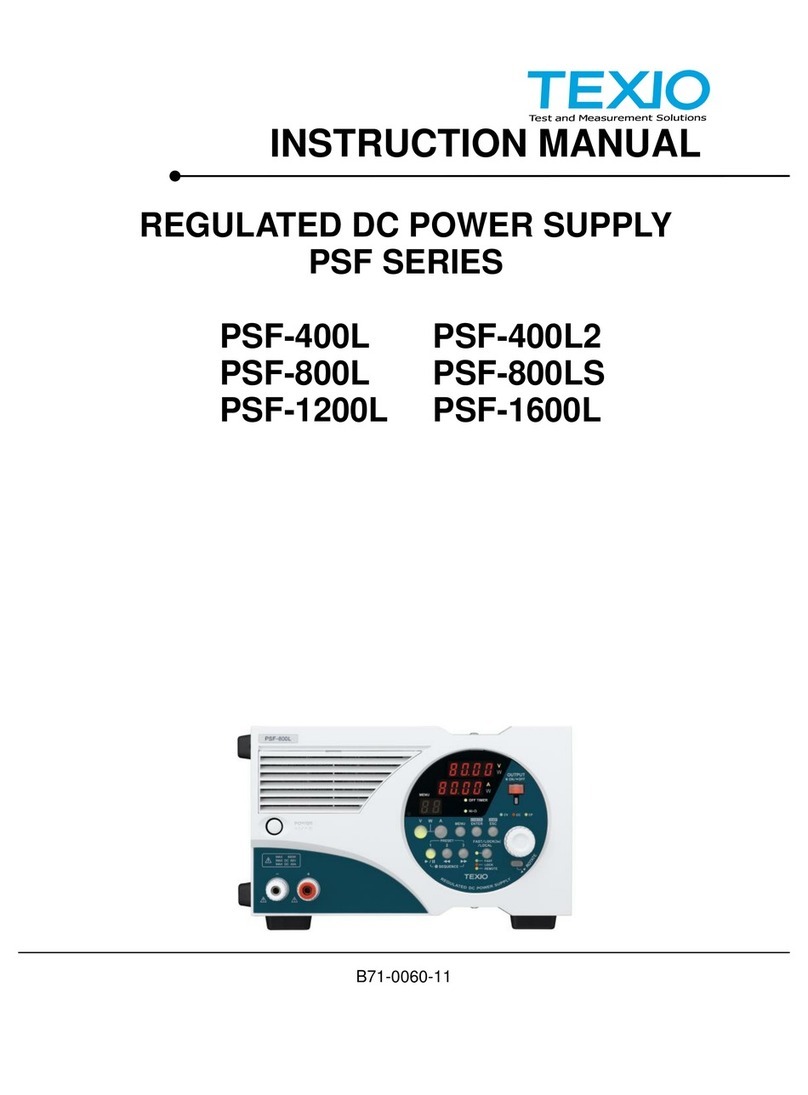
TEXIO
TEXIO PSF-1200L User manual
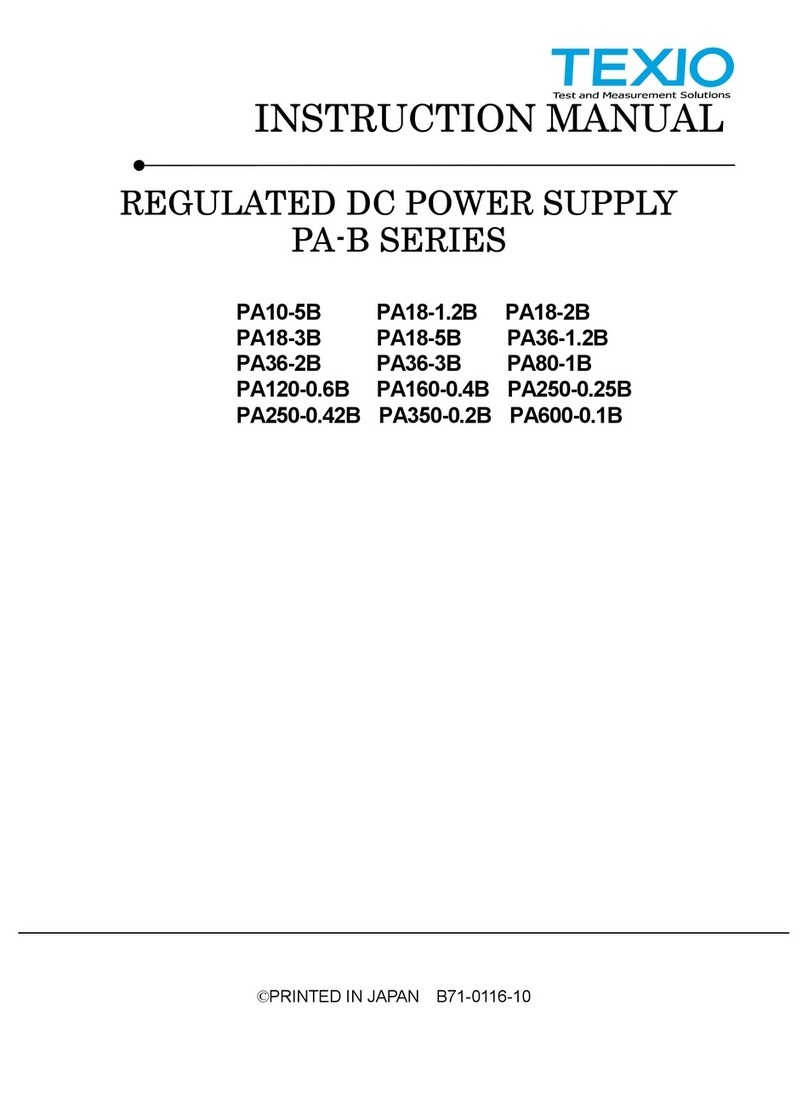
TEXIO
TEXIO PA10-5B User manual
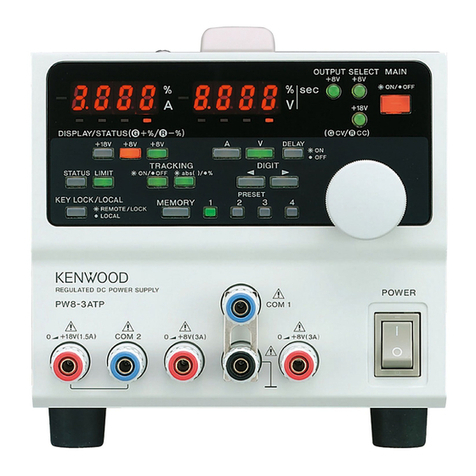
TEXIO
TEXIO PW8-3AQP User manual
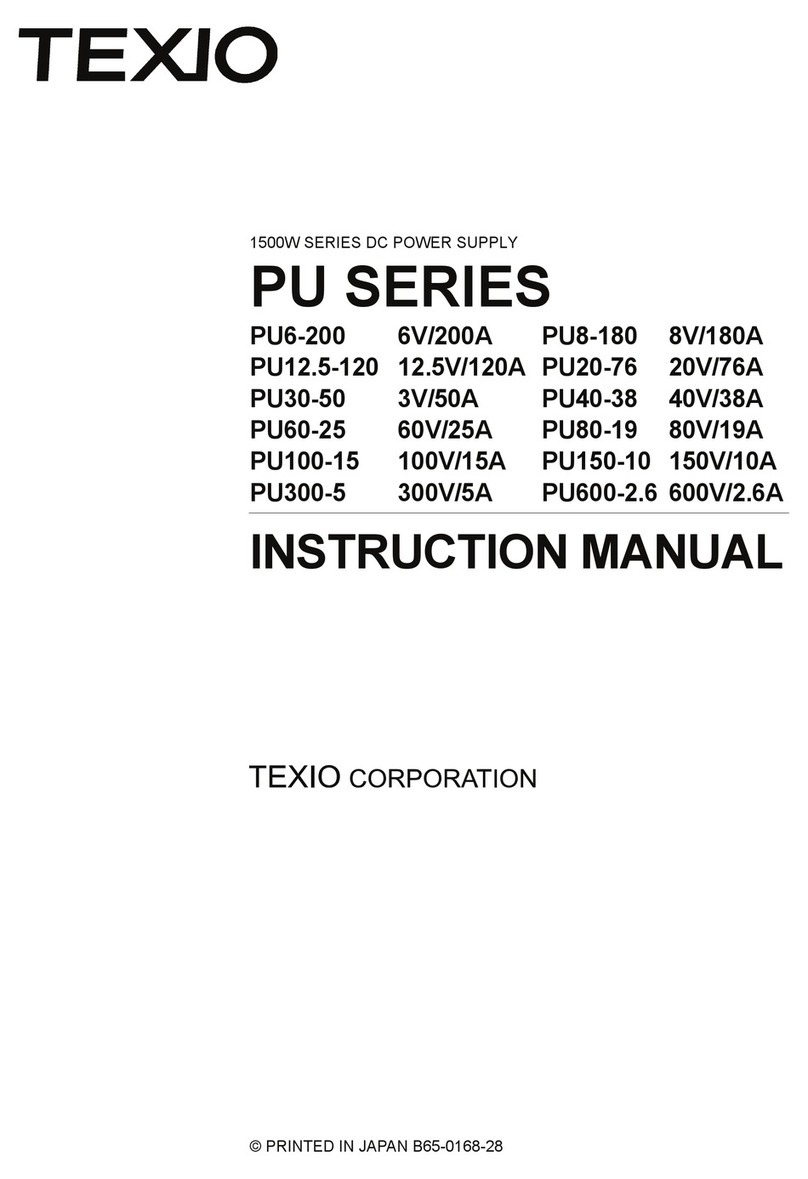
TEXIO
TEXIO PU6-200 User manual
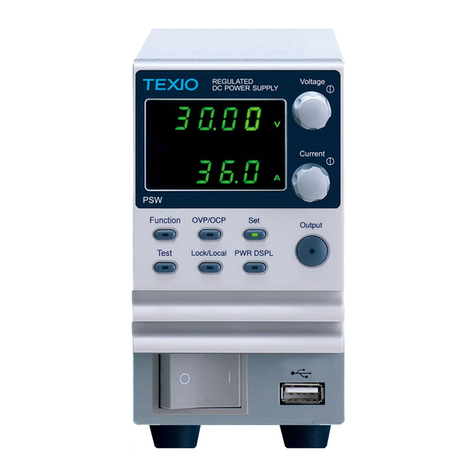
TEXIO
TEXIO PSW Series User manual

TEXIO
TEXIO PU6-200 User manual
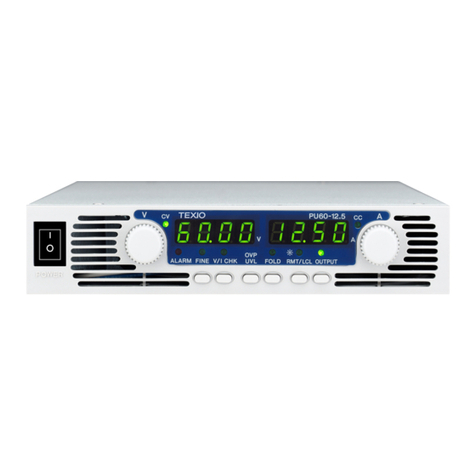
TEXIO
TEXIO PU Series User manual
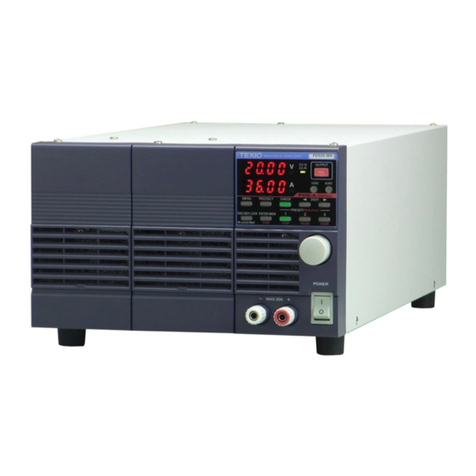
TEXIO
TEXIO PDS20-10A User manual

TEXIO
TEXIO PFR-100 SERIES Owner's manual

TEXIO
TEXIO PFR-100M250 Manual
Popular Power Supply manuals by other brands
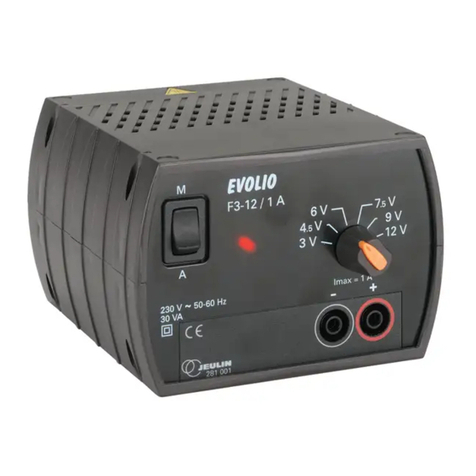
Jeulin
Jeulin EVOLIO F3-12 / 1A quick start guide
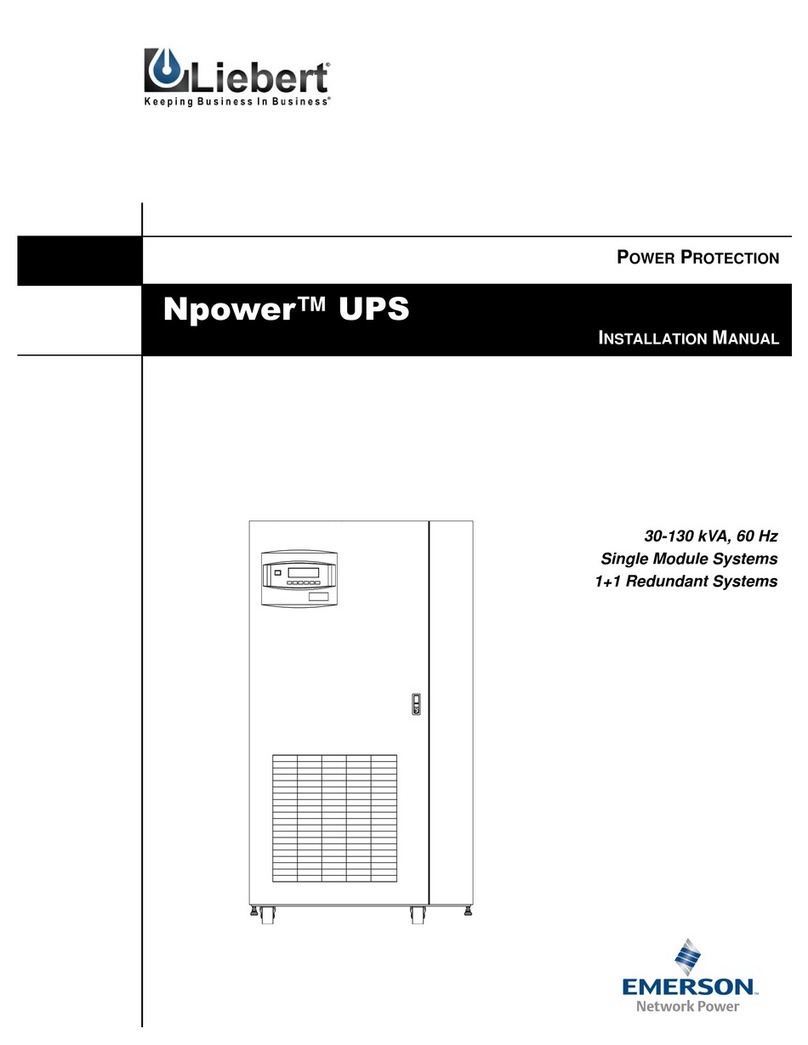
Emerson
Emerson Liebert Npower 30-130 kVA installation manual
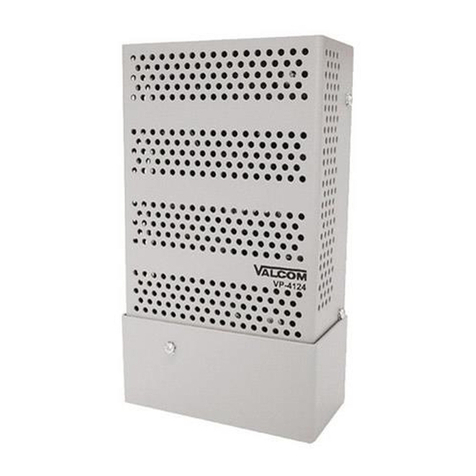
Valcom
Valcom VP-4124 Technical specifications
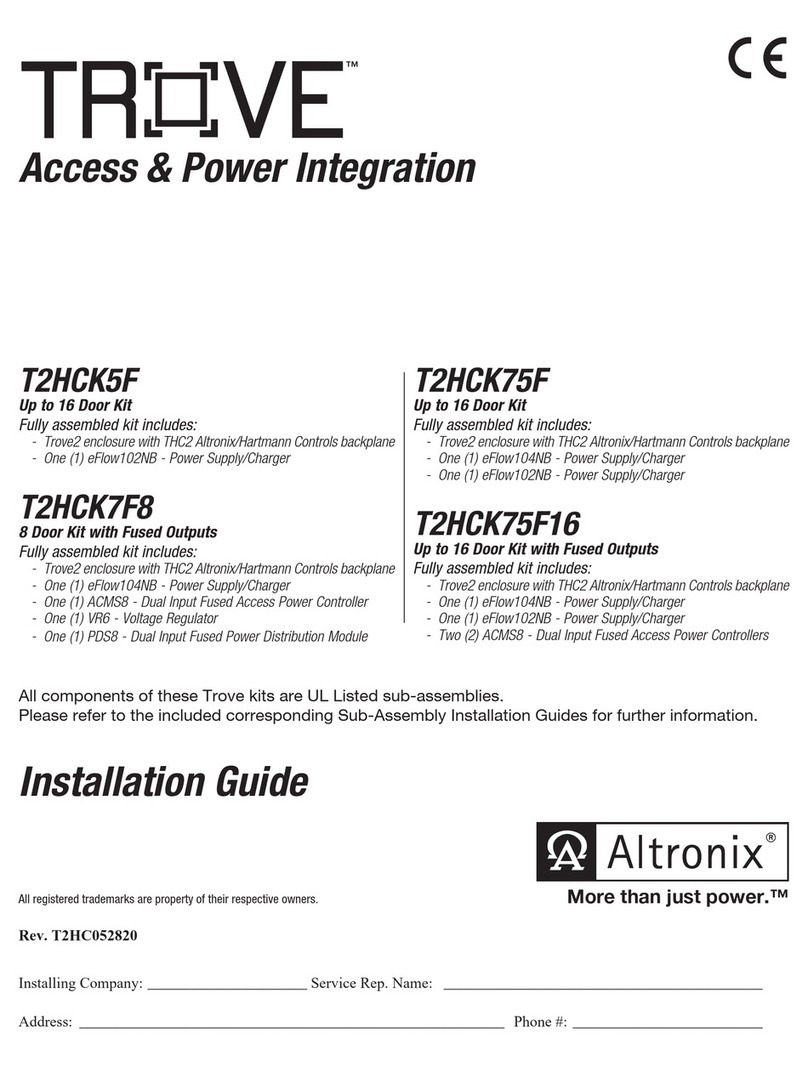
Altronix
Altronix Trove T2HCK5F installation guide
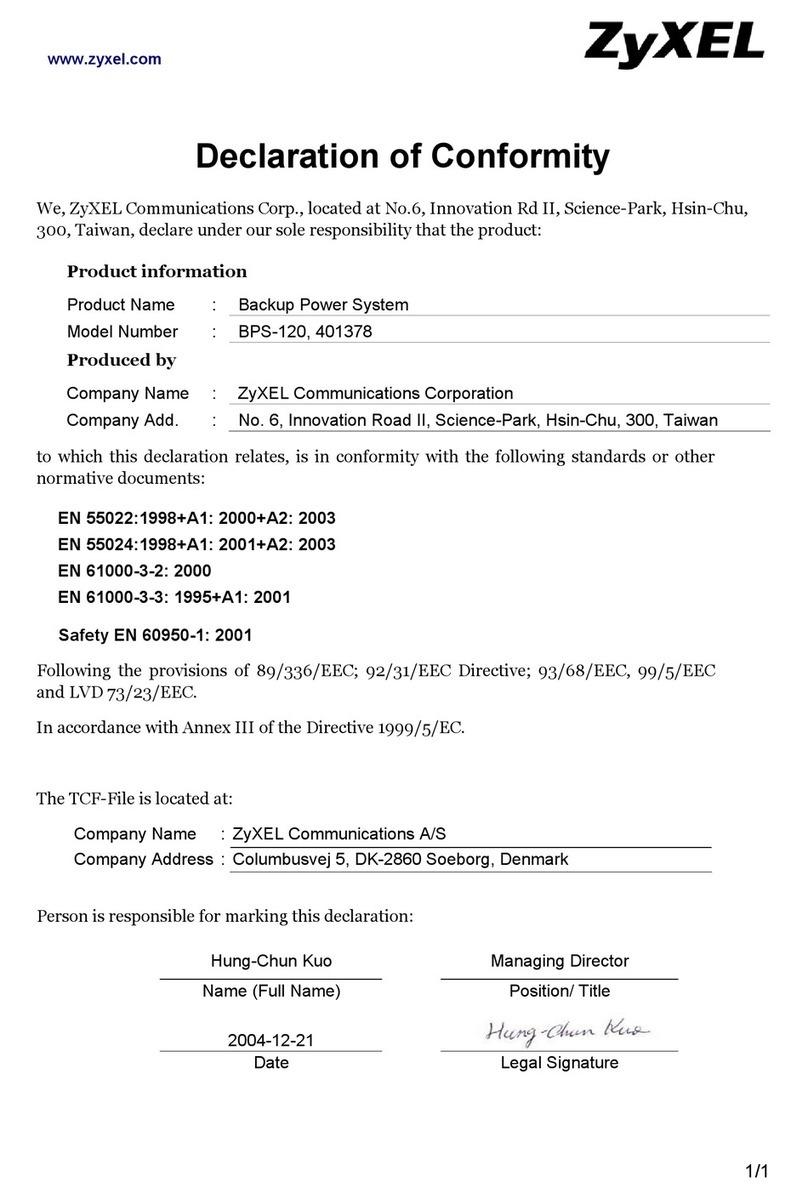
ZyXEL Communications
ZyXEL Communications BPS-120 Declaration of conformity
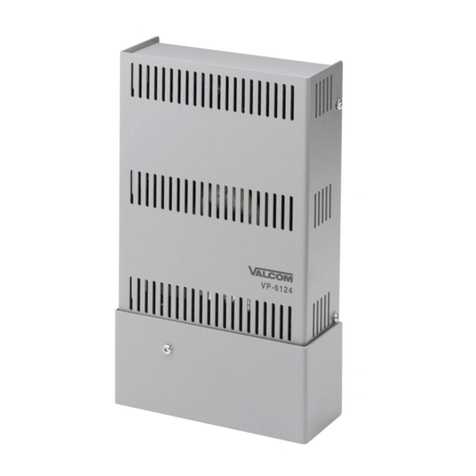
Valcom
Valcom VP-6124 Technical specifications
